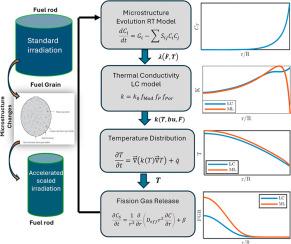Implications of point defect accumulation on UO2 thermal conductivity and fission gas release under accelerated fuel irradiation
IF 3.2
2区 工程技术
Q3 MATERIALS SCIENCE, MULTIDISCIPLINARY
引用次数: 0
Abstract
Evaluation of thermal properties is a crucial factor for nuclear fuel performance. During reactor operation, the accumulation of fission products and irradiation-induced lattice defects are responsible for degradation in thermal conductivity. This affects fuel temperature and fission gas release (FGR) among other multiphysics processes important for economics and safety analysis. However, the point defects (PD) induced thermal conductivity reduction are not treated mechanistically in the current fuel performance codes (FPC). In this study, we analyze the implications of PD accumulation described using a rate theory (RT) model on the lattice thermal conductivity of UO2 by adopting Lucuta thermal conductivity correlation (LC). We demonstrate that fission rate-dependent point defect concentrations have the largest impact on in-pile thermal conductivity in the periphery of light water reactor fuel below a temperature threshold governed by the migration barrier of defects. The reduction of thermal conductivity in the low -temperature rim region acts as additional thermal resistance and leads to a temperature notably larger than suggested by LC specifically at low burnups. These effects are anticipated to have notable impacts on fuel during the accelerated conditions. The impact of incorporating a point defect-informed approach to thermal conductivity is assessed through a detailed analysis of fission gas release behavior and fuel microstructure evolution. Finally, a fission rate-dependent correction to the Lucuta correlation is proposed as part of this analysis. The modified Lucuta correlation demonstrates higher FGR compared to the original correlation, although the accelerated irradiation process leads to a reduction in overall FGR. Once additional multiphysics mechanisms tightly coupled to temperature profile are introduced it becomes harder to deconvolve the impact of point defects.

加速燃料辐照下点缺陷积累对UO2导热性和裂变气体释放的影响
热性能的评价是核燃料性能的一个关键因素。在反应堆运行过程中,裂变产物的积累和辐照引起的晶格缺陷是导致导热性能下降的原因。这影响燃料温度和裂变气体释放(FGR)等多物理场过程,对经济和安全分析非常重要。然而,目前的燃料性能规范(FPC)并未对点缺陷(PD)引起的导热系数降低进行机械处理。在本研究中,我们采用Lucuta导热系数相关(LC)分析了用速率理论(RT)模型描述的PD积累对UO2晶格导热系数的影响。我们证明,在由缺陷迁移屏障控制的温度阈值以下,与裂变速率相关的点缺陷浓度对轻水反应堆燃料外围堆内导热系数的影响最大。低温边缘区域导热系数的降低作为额外的热阻,导致温度明显高于LC建议的温度,特别是在低燃烧时。预计这些影响将对加速工况下的燃油产生显著影响。通过对裂变气体释放行为和燃料微观结构演变的详细分析,评估了采用点缺陷信息方法对导热性的影响。最后,作为分析的一部分,提出了Lucuta相关的裂变率相关修正。修正后的Lucuta相关表明,与原始相关相比,FGR更高,尽管辐照过程加速导致总体FGR降低。一旦引入与温度分布紧密耦合的额外多物理场机制,就很难对点缺陷的影响进行反卷积。
本文章由计算机程序翻译,如有差异,请以英文原文为准。
求助全文
约1分钟内获得全文
求助全文
来源期刊

Journal of Nuclear Materials
工程技术-材料科学:综合
CiteScore
5.70
自引率
25.80%
发文量
601
审稿时长
63 days
期刊介绍:
The Journal of Nuclear Materials publishes high quality papers in materials research for nuclear applications, primarily fission reactors, fusion reactors, and similar environments including radiation areas of charged particle accelerators. Both original research and critical review papers covering experimental, theoretical, and computational aspects of either fundamental or applied nature are welcome.
The breadth of the field is such that a wide range of processes and properties in the field of materials science and engineering is of interest to the readership, spanning atom-scale processes, microstructures, thermodynamics, mechanical properties, physical properties, and corrosion, for example.
Topics covered by JNM
Fission reactor materials, including fuels, cladding, core structures, pressure vessels, coolant interactions with materials, moderator and control components, fission product behavior.
Materials aspects of the entire fuel cycle.
Materials aspects of the actinides and their compounds.
Performance of nuclear waste materials; materials aspects of the immobilization of wastes.
Fusion reactor materials, including first walls, blankets, insulators and magnets.
Neutron and charged particle radiation effects in materials, including defects, transmutations, microstructures, phase changes and macroscopic properties.
Interaction of plasmas, ion beams, electron beams and electromagnetic radiation with materials relevant to nuclear systems.
 求助内容:
求助内容: 应助结果提醒方式:
应助结果提醒方式:


